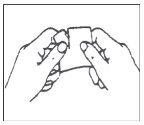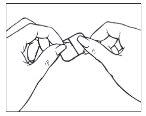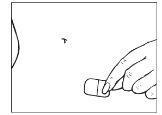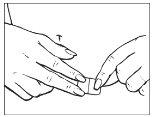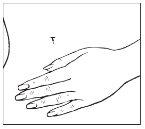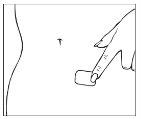
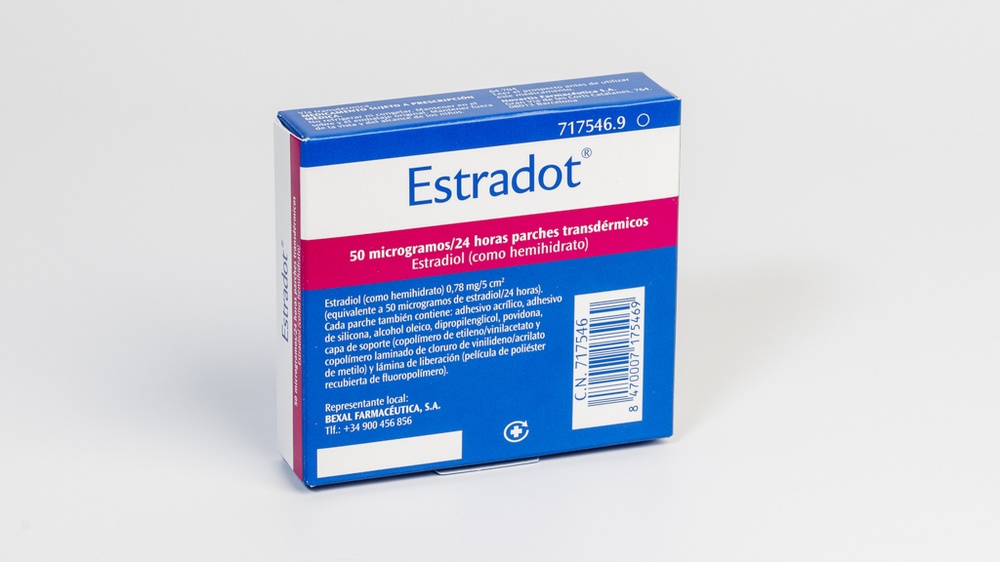
ЕСТРАДОТ 50 мікрограм/24 години, трансдермальний пластир

Запитайте лікаря про рецепт на ЕСТРАДОТ 50 мікрограм/24 години, трансдермальний пластир

Інструкція із застосування ЕСТРАДОТ 50 мікрограм/24 години, трансдермальний пластир
Введення
Опис: інформація для користувача
Естрадот 50 мікрограм/24 години трансдермальна пластина
Естрадіол (у вигляді гемігідрату)
Всією увагою прочитайте цей опис перед початком використання цього лікарського засобу, оскільки він містить важливу інформацію для вас.
- Збережіть цей опис, оскільки вам може знадобитися знову його прочитати.
- Якщо у вас виникли питання, проконсультуйтеся з вашим лікарем або фармацевтом.
- Цей лікарський засіб призначений тільки вам і не слід давати його іншим людям, навіть якщо вони мають такі самі симптоми, як і ви, оскільки це може їм зашкодити.
- Якщо ви відчуваєте побічні ефекти, проконсультуйтеся з вашим лікарем або фармацевтом, навіть якщо це побічні ефекти, які не вказані в цьому описі. Див. розділ 4.
Зміст опису:
- Що таке Естрадот і для чого він використовується
- Що вам потрібно знати перед початком використання Естрадота
- Як використовувати Естрадот
- Можливі побічні ефекти
- Збереження Естрадота
- Зміст упаковки та додаткова інформація
1. Що таке Естрадот і для чого він використовується
Естрадот - це гормональна заміна терапія (ГЗТ), яка містить жіночий гормон естроген.
Естрадот використовується у жінок після менопаузи, коли минуло щонайменше 12 місяців з моменту останньої природної менструації.
Естрадот випускається у вигляді пластини, яку наклеюють на шкіру.
Естрадот використовується для:
Зняття симптомів, які з'являються під час менопаузи
Під час менопаузи кількість естрогенів, які виробляє організм жінки, зменшується. Це може викликати симптоми, такі як раптові спалахи жару на обличчі, шиї та грудях (припливи). Естрадот полегшує ці симптоми після менопаузи. Естрадот буде призначений тільки у тому випадку, якщо ваші симптоми серйозно ускладнюють вашу повсякденне життя.
Профілактика остеопорозу
Після менопаузи деякі жінки можуть розвивати хрупкість кісток (остеопороз). Проконсультуйтеся з вашим лікарем про всі доступні варіанти лікування. Якщо у вас високий ризик розвитку переломів через остеопороз і інші лікарські засоби не підходять вам, ви можете використовувати Естрадот для профілактики остеопорозу після менопаузи.
2. Що вам потрібно знати перед початком використання Естрадота
Медична історія та регулярні огляди
Використання ГЗТ пов'язане з ризиками, які потрібно враховувати при прийнятті рішення про використання або продовження лікування.
Досвід лікування жінок з ранньою менопаузою (через відмову яєчників або операцію) обмежений. Якщо у вас рання менопауза, ризики використання ГЗТ можуть бути іншими. Будь ласка, проконсультуйтеся з вашим лікарем.
Перед початком (або відновленням) ГЗТ ваш лікар запитає вас про вашу медичну історію та історію вашої сім'ї. Ваш лікар може вирішити провести фізичний огляд. Це може включати в себе огляд ваших грудей та/або внутрішній огляд, якщо це необхідно.
Після початку лікування Естрадотом вам потрібно відвідувати вашого лікаря для регулярних оглядів (щонайменше один раз на рік). Під час цих оглядів обговорюйте з вашим лікарем про користь та ризики продовження лікування Естрадотом.
Проводьте періодичні огляди молочних залоз, як рекомендує ваш лікар.
Не використовуйтеЕстрадот
якщо будь-який з наступних випадків стосується вас. Якщо ви не впевнені в будь-якому з цих пунктів, проконсультуйтеся з вашим лікаремперед використанням Естрадота.
Не використовуйте Естрадот:
- якщо ви страждаєте або страждали раком молочної залози, або якщо існує підозра, що ви можете мати його;
- якщо у вас є гормонозалежний рак, такий як рак внутрішньої оболонки матки (ендометрій), або якщо існує підозра, що ви можете мати його;
- якщо ви маєте анормальну вагінальну кровотечу;
- якщо у вас є гіперплазія ендометрія(зайва товщина внутрішньої оболонки матки) для якої ви не отримуєте лікування;
- якщо ви страждаєте або страждали тромбозом(утворенням кров'яних згустків у венах), наприклад, у ногах (глибокий венозний тромбоз) або в легенях (пульмональна емболія);
- якщо у вас є розлад згортання крові(наприклад, дефіцит білка С, білка С або антитромбіну);
- якщо ви страждаєте або страждали нещодавно захворюванням, викликаним утворенням кров'яних згустків в артеріях, таким як інфаркт міокарда, інсультабо стенокардія;
- якщо ви страждаєте або страждали захворюванням печінкиі ваші тести функції печінки не нормалізувалися;
- якщо у вас є рідкісне захворювання крові, яке передається від батьків до дітей (спадкове);
- якщо ви алергічні(гіпersenситивні) до естрадіолу або до будь-якого іншого компоненту цього лікарського засобу (включаючи розділ 6 Зміст упаковки та додаткова інформація);
Якщо під час використання Естрадота ви відчуваєте будь-який з вищезазначених станів вперше, зупіньте лікування негайно і проконсультуйтеся з вашим лікарем якнайшвидше.
Попередження та обережність
Повідоміть вашого лікаря, якщо ви страждаєте або страждали будь-яким з наступних станів перед початком лікування, оскільки вони можуть повторитися або погіршитися під час лікування Естрадотом. У цьому випадку вам потрібно буде відвідувати вашого лікаря з більшою частотою для регулярних оглядів:
- міоми матки;
- ріст внутрішньої оболонки матки поза маткою (ендометріоз) або попередня історія зайвої товщини внутрішньої оболонки матки (гіперплазія ендометрія);
- збільшення ризику утворення кров'яних згустків (див. «Кров'яні згустки в венах (тромбоз»;
- збільшення ризику розвитку гормонозалежного раку (наприклад, коли ваша мати, сестра або бабушка страждали раком молочної залози);
- збільшення артеріального тиску;
- розлад функції печінки, наприклад, доброякісна пухлина печінки;
- цукровий діабет;
- камені в жовчному міхурі (жовчові камені);
- мігрень або сильний головний біль;
- захворювання імунної системи, яке впливає на кілька органів тіла (системний червоний вовчак, СЧВ);
- епілепсія;
- бронхіальна астма;
- захворювання, яке впливає на барабанну перепонку та слуховий апарат (отосклероз);
- високий рівень жиру в крові (тригліцериди);
- задержання рідини через проблеми з серцем або нирками;
- спадковий та набутий ангіоневротичний набряк.
Зупіньте використання Естрадота та зверніться до лікаря негайно.
Якщо ви відчуваєте будь-який з наступних станів під час використання ГЗТ:
- будь-який з умов, згаданих у розділі «Не використовуйте Естрадот»
- жовтуха шкіри або білкової оболонки очей (жовтяниця). Це може бути ознакою захворювання печінки
- набряк обличчя, язика або горла та труднощі з ковтанням або кропив'янка, супроводжувані труднощами з диханням, які свідчать про ангіоневротичний набряк;
- значне збільшення артеріального тиску (симптоми можуть бути головний біль, втома, головокружіння)
- головні болі типу мігрені, які виникають вперше
- якщо ви завагітніли
- якщо ви відчуваєте ознаки кров'яного згустку, такі як:
- біль та набряк ноги;
- раптовий біль у грудях;
- труднощі з диханням.
Для ознак кров'яного згустку див. «Зупіньте використання Естрадота та зверніться до лікаря негайно».
Примітка: Естрадот не є контрацептивом. Якщо минуло менше 12 місяців з моменту вашої останньої менструації або вам менше 50 років, ви можете ще потребувати додаткових контрацептивних заходів для запобігання вагітності. Проконсультуйтеся з вашим лікарем для отримання поради.
ГЗТ та рак
Гіперплазія ендометрія (зайва товщина внутрішньої оболонки матки) та рак ендометрія
Використання ГЗТ з продуктами тільки естрогену збільшить ризик розвитку гіперплазії ендометрія та раку ендометрія.
Додання прогестагену до лікування естрогеном протягом щонайменше 12 днів кожного циклу з 28 днів захистить вас від цього додаткового ризику. Тому ваш лікар призначить прогестаген окремо, якщо у вас ще є матка. Якщо вам видалили матку (гістеректомія), запитайте вашого лікаря про те, чи можете ви безпечно використовувати цей лікарський засіб без використання прогестагену.
У жінок віком від 50 до 65 років, які мають матку і не приймають ГЗТ, у середньому 5 з 1000 жінок будуть діагностовані з раком ендометрія.
У жінок віком від 50 до 65 років, які мають матку і приймають ГЗТ з тільки естрогеном, від 10 до 60 жінок з 1000 будуть діагностовані з раком ендометрія (це означає від 5 до 55 додаткових випадків), залежно від дози та тривалості терапії.
Несподівані кровотечі
Ви будете відчувати кровотечу один раз на місяць (так звану менструальну кровотечу) під час використання Естрадота в поєднанні з прогестагеном. Але якщо ви відчуваєте кровотечі або плями крові, які не входять до вашої регулярної менструальної кровотечі, які:
- тривають понад 6 перших місяців;
- починаються після того, як ви вже приймаєте Естрадот понад 6 місяців;
- тривають після того, як ви зупинили використання Естрадота;
зверніться до лікаря якнайшвидше.
Рак молочної залози
Докази свідчать про те, що використання ГЗТ з комбінацією естроген-прогестаген або тільки естрогеном збільшує ризик розвитку раку молочної залози. Додатковий ризик залежить від тривалості використання ГЗТ. Додатковий ризик стає очевидним після 3 років використання. Після припинення ГЗТ додатковий ризик зменшується з часом, але ризик може зберігатися протягом 10 років або більше, якщо ви приймаєте ГЗТ понад 5 років.
Порівняння
У жінок віком від 50 до 54 років, які не приймають ГЗТ, у середньому 13-17 з 1000 жінок будуть діагностовані з раком молочної залози протягом 5-річного періоду.
У жінок віком 50 років, які починають гормональну заміну терапію тільки з естрогеном на 5 років, буде від 16 до 17 випадків на 1000 жінок (це означає від 0 до 3 додаткових випадків).
У жінок віком 50 років, які починають лікування ГЗТ з комбінацією естроген-прогестаген на 5 років, буде 21 випадок на 1000 жінок (це означає від 4 до 8 додаткових випадків).
У жінок віком від 50 до 59 років, які не приймають ГЗТ, буде діагностовано у середньому 27 випадків раку молочної залози на 1000 жінок протягом 10-річного періоду.
У жінок віком 50 років, які починають гормональну заміну терапію тільки з естрогеном на 10 років, буде 34 випадки на 1000 жінок (це означає 7 додаткових випадків).
У жінок віком 50 років, які починають лікування ГЗТ з комбінацією естроген-прогестаген на 10 років, буде 48 випадків на 1000 жінок (це означає 21 додатковий випадок).
- Періодично оглядають ваші груди. Зверніться до лікаря, якщо ви виявите будь-які зміни, наприклад:
- борозни або заглибини на шкірі;
- зміни в сосках;
- будь-який шишка, який ви можете побачити або відчувати.
Крім того, вам рекомендується брати участь у програмах скринінгу за допомогою мамографії. Під час скринінгової мамографії важливо повідомити медсестрі або лікарю, який проводить рентген, що ви приймаєте ГЗТ, оскільки цей лікарський засіб може збільшити щільність ваших грудей, що може вплинути на результат мамографії. Коли щільність грудей збільшується, мамографія може не виявити всі шишки.
Рак яєчників
Рак яєчників трапляється рідше, ніж рак молочної залози. Використання ГЗТ з тільки естрогеном або з комбінацією естроген-прогестаген асоціюється з трохи більшим ризиком розвитку раку яєчників.
Ризик розвитку раку яєчників змінюється з віком. Наприклад, у жінок віком від 50 до 54 років, які не приймають ГЗТ, спостерігається близько 2 випадки раку яєчників на 2000 жінок протягом 5-річного періоду. У жінок, які приймають ГЗТ протягом 5 років, спостерігається близько 3 випадки на 2000 жінок (це означає близько 1 додаткового випадку).
Вплив ГЗТ на серце та кровообіг
Кров'яні згустки в венах (тромбоз)
Ризик утворення кров'яних згустків у венахприблизно в 1,3-3 рази вищий для жінок, які приймають ГЗТ, ніж для тих, хто не приймає, особливо протягом першого року лікування.
Кров'яні згустки можуть бути серйозними, і якщо один з них переміститься в легені, це може викликати біль у грудях, труднощі з диханням, втрату свідомості або навіть смерть.
Ви маєте більший ризик розвитку кров'яного згустку в ваших венах з віком і якщо ви відчуваєте будь-який з наступних станів. Повідоміть вашому лікарю, якщо будь-який з цих станів стосується вас:
- ви не можете ходити протягом тривалого періоду через операцію, травму або захворювання (див. також розділ 3, Якщо вам потрібно операція);
- у вас є значна зайва вага (ІМТ > 30 кг/м2);
- у вас є розлад згортання крові, який потребує тривалого лікування лікарськими засобами, які використовуються для профілактики утворення кров'яних згустків;
- якщо ваші близькі родичі мали будь-коли кров'яний згусток у ногах, легенях або іншому органі;
- якщо у вас є системний червоний вовчак (СЧВ);
- якщо у вас є рак.
Для ознак кров'яного згустку див. «Зупіньте використання Естрадота та зверніться до лікаря негайно».
Порівняння
У жінок віком 50 років, які не приймають ГЗТ, очікується, що у середньому 4-7 з 1000 жінок будуть мати кров'яний згусток у венах протягом 5-річного періоду.
У жінок віком 50 років, які приймають ГЗТ з комбінацією естроген-прогестаген протягом 5 років, буде 9-12 випадків на 1000 жінок (це означає 5 додаткових випадків).
У жінок віком 50 років, яким видалили матку і які приймають ГЗТ з тільки естрогеном протягом 5 років, буде 5-8 випадків на 1000 жінок (це означає 1 додатковий випадок).
Серцеве захворювання (інфаркт міокарда)
Немає доказів того, що ГЗТ запобігає інфаркту міокарда.
Жінки віком понад 60 років, які приймають ГЗТ з комбінацією естроген-прогестаген, мають трохи більший ризик розвитку серцевого захворювання, ніж ті, хто не приймає ГЗТ.
У жінок, яким видалили матку і які приймають ГЗТ з тільки естрогеном, немає збільшення ризику розвитку серцевого захворювання.
Інсульт
Ризик розвитку інсульту приблизно в 1,5 рази вищий для жінок, які приймають ГЗТ, ніж для тих, хто не приймає. Кількість додаткових випадків інсульту через використання ГЗТ збільшується з віком.
Порівняння
У жінок віком 50 років, які не приймають ГЗТ, у середньому 8 з 1000 жінок, ймовірно, будуть мати інсульт протягом 5-річного періоду. У жінок віком 50 років, які приймають ГЗТ, 11 з 1000 жінок, ймовірно, будуть мати інсульт протягом 5-річного періоду (це означає 3 додаткових випадки).
Інші стани
- ГЗТ не запобігає втраті пам'яті. Є деякі докази того, що існує більший ризик втрати пам'яті у жінок, які починають ГЗТ після 65 років. Проконсультуйтеся з вашим лікарем для отримання поради.
Інші лікарські засоби та Естрадот
Деякі лікарські засоби можуть вплинути на дію Естрадота. Це може викликати нерегулярні кровотечі. Це відбувається з наступними лікарськими засобами:
- Лікарські засоби проти епілепсії (наприклад, фенобарбітал, фенітоїн, карбамазепін);
- Лікарські засоби проти туберкульозу (наприклад, рифампіцин, рифабутин);
- Лікарські засоби проти ВІЛ (наприклад, невірапін, ефавіренз, ритонавір, нелфінавір);
- Препарати на основі лікарських рослин, які містять звіробій (Hypericum perforatum);
ГЗТ може вплинути на дію інших лікарських засобів:
- Лікарський засіб проти епілепсії (ламотриджин), оскільки це може збільшити частоту нападів.
- Інші антиінфекційні лікарські засоби (наприклад, кетоконазол, еритроміцин).
- Комбінації для лікування вірусу гепатиту С (ВГС) омбітасвір/парітапревір/ритонавір та дасабувір з або без рибавірину; глекапревір/пібрентасвір або софосбувір/велпатасвір/воксілапревір (див. розділ 4.4), можуть викликати підвищення результатів аналізів крові функції печінки (збільшення ферменту печінки АЛТ) у жінок, які приймають ГЗТ, яка містить етинілестрадіол. Естрадот містить естрадіол замість етинілестрадіолу. Невідомо, чи може збільшитися фермент печінки АЛТ при використанні Естрадота з цією комбінацією для лікування ВГС. Ваш лікар проінформує вас про це.
Будь ласка, повідоміть вашому лікарю або фармацевту, якщо ви приймаєте або нещодавно приймали інші лікарські засоби, включно з тим, які ви купили без рецепта, лікарські рослини або інші природні продукти. Ваш лікар проінформує вас про це.
Аналізи крові
Якщо вам потрібно зробити аналіз крові, повідоміть вашому лікарю або персоналу лабораторії, що ви приймаєте Естрадот, оскільки цей лікарський засіб може вплинути на результати деяких аналізів.
Вагітність та лактація
Естрадот - це лікарський засіб тільки для жінок після менопаузи. Якщо ви завагітніли, зупіньте лікування Естрадотом і зверніться до лікаря.
Не використовуйте Естрадот, якщо ви вагітні або під час лактації.
Водіння автомобіля та використання машин
Естрадот не має відомих впливів на здатність водити автомобіль або використовувати машини.
3. Як використовувати Естрадот
Слідкуйте точно інструкціям щодо застосування цього лікарського засобу, вказаним вашим лікарем. Про консультацію з вашим лікарем або фармацевтом, якщо у вас виникли питання.
Ваш лікар буде намагатися призначити вам найнижчу дозу для лікування вашого симптому протягом найкоротшого можливого періоду. Поговоріть з вашим лікарем, якщо ви вважаєте, що ця доза надто сильна або недостатня.
Як довго слід використовувати Естрадот
Важливо використовувати найнижчу ефективну дозу та лише тоді, коли це необхідно.
Періодично вам потрібно буде обговорювати з вашим лікарем можливі ризики та переваги, пов'язані з використанням Естрадота, та чи вам ще потрібне це лікування.
Коли розпочинати лікування
- Якщо ви зараз не використовуєте жодного гормонального заміщення (платівці або таблетки), або якщо ви використовували продукт гормонального заміщення безперервного комбінованого лікування (в якому застосовуються естроген і прогестаген кожен день без перерви), ви можете розпочати використовувати Естрадот будь-якого дня.
- Якщо ви перейдете з циклічного або послідовного гормонального заміщення (в якому прогестаген додається протягом 12-14 днів циклу), ви повинні розпочати використовувати Естрадот наступного дня після завершення попереднього режиму.
Коли застосовувати Естрадот
- Кожен платівець Естрадота повинен бути змінений двічі на тиждень (кожні 3-4 дні). Найкраще змінювати його завжди в два тих же дні тижня (наприклад, понеділок і четвер). Упаковка Естрадота містить календар-контроль на зворотному боці, який допоможе вам пам'ятати свій графік. Відмітьте графік двох днів на тиждень, який ви хочете дотримуватися. Змінюйте завжди платівець у два дні тижня, які ви відмітили.
- Ви повинні носити платівець Естрадота безперервно до моменту зміни його на новий платівець.
Будь-який клей, який залишається на шкірі, можна легко видалити шляхом тертя. Якщо це трапиться, помістіть новий платівець Естрадота в інше місце на шкірі.
Жінки, яким видалили матку
Платівець Естрадота повинен бути застосований безперервно без перерви. Не потрібно додавати інший тип гормону, званий прогестаген, якщо немає росту ендометрію поза маткою (ендометріоз). Перевірте ризики, які потрібно враховувати при гормональному лікуванні заміщення в розділі 2, Попередження та застереження.
Жінки, які зберегли матку
Ваш лікар призначить вам інший гормон для прийому з Естрадотом, званий прогестерон, для зменшення ризику раку матки. Якщо ви застосовуєте Естрадот безперервно без перерви, таблетку прогестерону потрібно буде приймати протягом щонайменше 12-14 днів кожному місяцю/циклу 28 днів. Перевірте ризики, які потрібно враховувати при гормональному лікуванні заміщення в розділі 2, Попередження та застереження.
Ви можете зазнавати нерегулярних кровотеч або плямування під час перших місяців лікування. Якщо у вас є сильні кровотечі або кровотеча чи плямування триває після кількох місяців лікування, поговоріть з вашим лікарем, щоб він міг переоцінити ваше лікування, якщо це необхідно (див. розділ 2, Несподівані кровотечі).
Де застосовувати Естрадот
Застосовуйте платівець на нижній частині живота, нижче пояса. Уникайте пояса, оскільки одяг може викликати відсмиктування платівця. Не застосовуйте платівець на груди або поблизу грудей.
Коли ви змінюєте платівець, згідно з вашим графіком двічі на тиждень, застосовуйте новий платівець в іншому місці. Не застосовуйте новий платівець в тому самому місці протягом щонайменше однієї тижня.
Перед застосуванням Естрадота переконайтесь, що ваша шкіра:
- чиста, суха та свіжа,
- вільна від будь-якого пилу, масла, крему чи лосьйону,
- вільна від порізів та/або подразнень.
Як застосовувати Естрадот
Кожен платівець знаходиться в окремому захисному пакеті. Відкрийте пакет по розрізу та витягніть платівець (не використовуйте ножиці для відкриття пакета, оскільки вони можуть пошкодити платівець).
| |
Охоронна плівка покриває клеївську сторону платівця. Цю плівку потрібно зняти перед застосуванням платівця на шкіру. Застосовуйте платівець негайно після відкриття пакета та видалення охоронної плівки. Візьміть платівець з охоронною плівкою, зверненою до вас. Зніміть половину захисної плівки та викиньте її. Спробуйте уникнути дотику до клеївської сторони платівця пальцями.
| |
Візьміть іншу половину захисної плівки, застосуйте клеївську сторону платівця до сухої ділянки нижньої частини живота. Натисніть клеївську сторону проти шкіри, щоб вона правильно приклеїлася, особливо по краях. Видаліть іншу частину охоронної плівки.
| |
Утримуйте прямий край охоронної плівки та зніміть її з платівця.
| |
Натисніть клеївську сторону проти шкіри, щоб вона правильно приклеїлася. Натисніть платівець твердо на шкіру долонею руки протягом щонайменше 10 секунд.
| |
Переконайтесь, що платівець був правильно застосований на шкіру, та проведіть пальцями по краях, щоб перевірити добрий контакт між платівцем та шкірою.
| |
При зміні платівця зніміть його, та згорніть його вдвічі з клеївською стороною всередину. Див. розділ 5, "Зберігання Естрадота" для отримання інструкцій щодо безпечного видалення платівця. Не викидайте використані платівці в туалет.
Додаткова практична інформація
Якщо платівець був застосований правильно, він не повинен впливати на вашу ванну, плавання, душ або вправи. Якщо платівець відсмикнувся, наприклад, під час ванні або душу, поверніть його, щоб видалити воду. Після висихання та охолодження шкіри ви можете застосувати той самий платівець в іншому місці на шкірі нижньої частини живота (див. "Де застосовувати Естрадот").
Якщо платівець не приклеївся повністю до шкіри, використовуйте новий платівець. Незалежно від того, в який день це трапиться, поверніть цей платівець у той самий день, згідно з початковим графіком.
Під час прийому сонячних ванн або використання солярію вам потрібно буде прикрити платівець. Під час купання ви можете носити платівець під купальником.
Якщо вам потрібно хірургічне втручання
Якщо ви плануєте хірургічне втручання, повідоміть про це вашого хірурга, що ви використовуєте Естрадот. Вам, можливо, потрібно буде припинити використання Естрадота за 4-6 тижнів до операції, щоб зменшити ризик утворення кров'яного згустку (див. розділ 2, Кров'яні згустки в вені). Спитайте у вашого лікаря, коли ви можете знову розпочати лікування Естрадотом.
Якщо ви використовуєте більше Естрадота, ніж потрібно
Якщо ви прийняли надто багато Естрадота, вам потрібно буде зняти платівець. Симптоми передозування зазвичай включають боль у грудях та/або вагінальне кровотеча. Передозування є малоймовірним через шлях введення Естрадота (платівець виділяє лікарський засіб поступово). Якщо симптоми тривають, вам потрібно буде зв'язатися з вашим лікарем.
Якщо ви забули застосувати Естрадот
Якщо ви забули змінити платівець, застосуйте інший платівець якнайшвидше, коли ви про це пам'ятайте. Незалежно від того, в який день це трапиться, поверніть цей платівець у той самий день, згідно з початковим графіком.
Не приймайте подвійну дозу для компенсації забутого застосування.
Якщо ви припиняєте лікування Естрадотом
Припинення лікування Естрадотом може збільшити ризик нерегулярних кровотеч або плямування. Повідоміть про це вашого лікаря, якщо це трапиться. Після тривалого періоду без лікування вам потрібно буде проконсультуватися з вашим лікарем, перш ніж знову розпочати використовувати платівець.
Якщо у вас є будь-які інші питання щодо використання цього лікарського засобу, спитайте у вашого лікаря або фармацевта.
4. Можливі побічні ефекти
Як і всі лікарські засоби, Естрадот може викликати побічні ефекти, хоча не всі люди їх відчувають.
Наступні захворювання спостерігаються частіше у жінок, які проходять гормональне лікування заміщення, порівняно з жінками, які не проходять таке лікування:
- рак грудей;
- анормальний ріст внутрішньої оболонки матки (гіперплазія ендометрію) або рак внутрішньої оболонки матки (рак ендометрію);
- рак яєчників;
- кров'яні згустки в венах ніг або легенів (тромбоемболія);
- серцево-судинні захворювання;
- інсульт;
- втрата пам'яті, якщо гормональне лікування заміщення розпочато після 65 років.
Для отримання більшої інформації про ці побічні ефекти див. розділ 2.
Деякі побічні ефекти можуть бути серйозними
Наступні симптоми потребують негайної медичної допомоги:
- Раптовий боль у грудях;
- Боль у грудях, яка поширюється на руку або шию;
- Затруднення дихання;
- Больове запалення та червоність ніг;
- Жовтізація очей та обличчя, потемніння сечі, свербіж шкіри (жовтяниця);
- Кровотечі або плямування, які не очікувалися після використання Естрадота протягом деякого часу або якщо це триває після припинення лікування;
- Зміни в грудях, такі як порушення шкіри грудей, зміни в сосках, шишки, які ви можете бачити або відчувати (рак грудей);
- Сильні менструальні кровотечі;
- Головні болі типу мігрені, які не пояснюються.
Припиніть лікування Естрадотом та негайно зв'яжіться з вашим лікарем, якщо ви відчуваєте будь-який з цих побічних ефектів.
Перевірте ризики, які потрібно враховувати при гормональному лікуванні заміщення в розділі 2, Попередження та застереження
Інші побічні ефекти
Естрадот також може викликати наступні побічні ефекти. Якщо ви вважаєте, що будь-який з побічних ефектів, які ви відчуваєте, є серйозним, повідоміть про це вашому лікарю або фармацевту.
Дуже часті побічні ефекти, які можуть виникнути у понад 1 з 10 осіб:
Головний біль, реакції на шкірі в місці застосування платівця (включаючи подразнення, печію, висип, сухість, кровотечу, синяки, запалення, набухання, пігментацію шкіри, кропив'янку та пухирці), напруження та біль у грудях, менструальний біль, порушення менструації.
Часті, які можуть виникнути у до 1 з 10 осіб:
Депресія, нервозність, зміни настрою, безсоння, нудота, погане травлення, діарея, біль у животі, відчуття набухання, акне, висип, суха шкіра, свербіж, зростання грудей, сильні менструальні кровотечі, виділення білого або жовтуватого слизу з вагіни, нерегулярні кровотечі, сильні скорочення матки, запалення вагіни, анормальний ріст матки (гіперплазія ендометрію), біль (наприклад, біль у спині, руках, ногах, зап'ястках, гомілках), слабкість, утримання рідини (едем) в кінцівках (руках і ногах), зміни ваги.
Менше часті, які можуть виникнути у до 1 з 100 осіб:
Мігрень, головокружіння, підвищення артеріального тиску, блювота, забарвлення шкіри, порушення функції печінки.
Рідкісні, які можуть виникнути у до 1 з 1000 осіб:
Оніміння або поколювання рук і ніг, кров'яні згустки, камені в жовчному міхурі, випадіння волосся, слабкість м'язів, доброякісний ріст матки, кісти біля маткових труб, пухирці (малі шишки) на шийці матки (цервікальному каналі), зміни сексуального потягу, алергічні реакції, такі як висип.
Дуже рідкісні, які можуть виникнути у до 1 з 10000 осіб:
Кропив'янка, ознаки серйозної алергічної реакції (включаючи труднощі з диханням; набухання обличчя, язика, горла або шкіри; головокружіння та кропив'янка), зниження толерантності до вуглеводів, мимовільні рухи, які можуть впливати на очі, голову та шию, незручність при використанні контактних лінз, серйозні реакції шкіри, надмірний ріст волосся.
Побічні ефекти з невідомою частотою(не можуть бути оцінені з наявних даних):
Рак грудей, аномальний тест функції печінки, алергічна інфільтрація шкіри, шишки в грудях (не ракові).
Наступні побічні ефекти були повідомлені при застосуванні інших гормональних засобів заміщення:
- хвороба жовчного міхуря
- різноманітні порушення шкіри:
- забарвлення шкіри, особливо обличчя або шиї, відоме як "відмітини вагітності" (хлоазма);
- больові вузлики та запалення шкіри (еритема вузликова);
- висип з червоним колором у вигляді цілі або пухирців (еритема багатоклітинна);
- зниження пам'яті або розумових здібностей (можлива деменція)
Повідомлення про побічні ефекти
Якщо ви відчуваєте будь-який побічний ефект, проконсультуйтеся з вашим лікарем або фармацевтом, навіть якщо це можливі побічні ефекти, які не перелічені в цьому листку. Ви також можете повідомити про них безпосередньо через Іспанську систему фармакологічного нагляду за лікарськими засобами для людини (http://www.notificaram.es). Повідомляючи про побічні ефекти, ви можете допомогти надати більше інформації про безпеку цього лікарського засобу.
5. Зберігання Естрадота
- Тримайте цей лікарський засіб поза зоною видимості та досягнення дітей.
- Зберігайте Естрадот в оригінальному пакеті, у прохолодному та сухому місці. Як тільки пакет буде відкрито або як тільки буде видалена охоронна плівка, застосуйте платівець на шкіру негайно.
- Не зберігайте Естрадот у холодильнику чи не заморожуйте його.
- Не використовуйте цей лікарський засіб після закінчення терміну придатності, вказаного на пакеті після CAD/EXP. Термін придатності - останній день місяця, який вказано.
- Не використовуйте цей лікарський засіб, якщо ви помітили, що пакет пошкоджено або має ознаки порушення.
- Після зняття платівця згорніть його вдвічі з клеївською стороною всередину та тримайте його в безпечному місці, поза зоною досягнення дітей. Використані або невикористані трансдермальні платівці потрібно видалити згідно з місцевими правилами або повернути до аптеки, найкраще в оригінальному пакеті.
- Лікарські засоби не повинні бути викинуті в каналізацію чи сміття. Відкладайте пакети та лікарські засоби, які вам не потрібні, у пункті збору аптеки. У разі сумнівів спитайте у вашого фармацевта, як позбутися пакетів та лікарських засобів, які вам не потрібні. Таким чином, ви допоможете захистити навколишнє середовище
.
6. Зміст упаковки та додаткова інформація
Склад Естрадота
Кожен платівець 50 мкг/24 години трансдермального застосування містить 0,78 мг естрадіолу (у вигляді гемігідрату) та виділяє близько 50 мкг естрадіолу кожні 24 години.
- Активний інгредієнт - естрадіол (у вигляді гемігідрату).
- Інші компоненти клеївської плівки платівця - акриловий клей, силіконовий клей, олеїнова кислота, дипропіленглікол, повідон (Е1201).
- Підтримуючий шар - кополімер етилену/вінілацетату та ламінований кополімер хлориду вінілідену/метакрилату.
- Охоронна плівка (яку потрібно зняти перед застосуванням платівця) - поліестерова плівка, покрита фторполімером.
Вигляд продукту та вміст упаковки
Естрадот 50 - прямокутний платівець площею 5 см² з округлими краями, складається з клеївської плівки, чутливої до тиску, яка містить естрадіол, прозорого підтримуючого шару на одній стороні та охоронної плівки на іншій.
Естрадот доступний у чотирьох різних концентраціях: 25, 37,5, 50 та 75 мкг/24 години. Можливо, не всі концентрації доступні.
Естрадот доступний у упаковках по 2, 8, 24 та 26 платівців. Можливо, не всі формати доступні.
Власник дозволу на маркетинг
BEXAL ФАРМАЦЕВТИКА, С.А.
Бізнес-центр Парке Норте
Будинок Робле
Вулиця Серрано Гальваче, 56
28033 Мадрид
Іспанія
Відповідальний за виробництво
Novartis ФАРМАЦЕВТИКА, С.А.
Гран-Віа де лес Кортс Каталанес, 764
08013 Барселона
Іспанія
Novartis Pharma GmbH
Ронстрасе 25
D-90429 Нюрнберг
Німеччина
Цей лікарський засіб дозволено в державах-членах Європейського економічного простору та у Великій Британії (Північній Ірландії) під наступними назвами:
Австрія: Естрадот
Данія: Вівель-дот
Фінляндія: Естрадот
Франція: Вівель-дот
Хорватія: Естрадот
Ісландія: Вівель-дот
Ірландія: Естрадот
Норвегія: Естрадот
Португалія: Естрадот
Іспанія: Естрадот
Швеція: Естрадот
Велика Британія (Північна Ірландія): Естрадот
Дата останнього перегляду цього листка:травень 2025
Інші джерела інформації
Детальна інформація про цей лікарський засіб доступна на сайті Іспанського агентства лікарських засобів та медичних продуктів (AEMPS) http://www.aemps.gob.es/
- Країна реєстрації
- Діючі речовини
- Потрібен рецептТак
- Виробник
- Інформація є довідковою і не є медичною порадою. Перед прийомом будь-яких препаратів обов'язково проконсультуйтеся з лікарем. Oladoctor не несе відповідальності за медичні рішення, прийняті на основі цього контенту.
- Альтернативи до ЕСТРАДОТ 50 мікрограм/24 години, трансдермальний пластирФорма випуску: ГЕЛЬ, 0,5 мгДіючі речовини: estradiolВиробник: Orion CorporationПотрібен рецептФорма випуску: ГЕЛЬ, 1 мгДіючі речовини: estradiolВиробник: Orion CorporationПотрібен рецептФорма випуску: ТРАНСДЕРМАЛЬНИЙ ПЛАСТИР, 3 мгДіючі речовини: estradiolВиробник: Merus Labs Luxco Ii S.À.R.L.Потрібен рецепт
Аналоги ЕСТРАДОТ 50 мікрограм/24 години, трансдермальний пластир в інших країнах
Найкращі аналоги з тією самою діючою речовиною та терапевтичним ефектом.
Аналог ЕСТРАДОТ 50 мікрограм/24 години, трансдермальний пластир у Poland
Аналог ЕСТРАДОТ 50 мікрограм/24 години, трансдермальний пластир у Ukraine
Лікарі онлайн щодо ЕСТРАДОТ 50 мікрограм/24 години, трансдермальний пластир
Консультація щодо дозування, побічних ефектів, взаємодій, протипоказань та поновлення рецепта на ЕСТРАДОТ 50 мікрограм/24 години, трансдермальний пластир – за рішенням лікаря та згідно з місцевими правилами.




